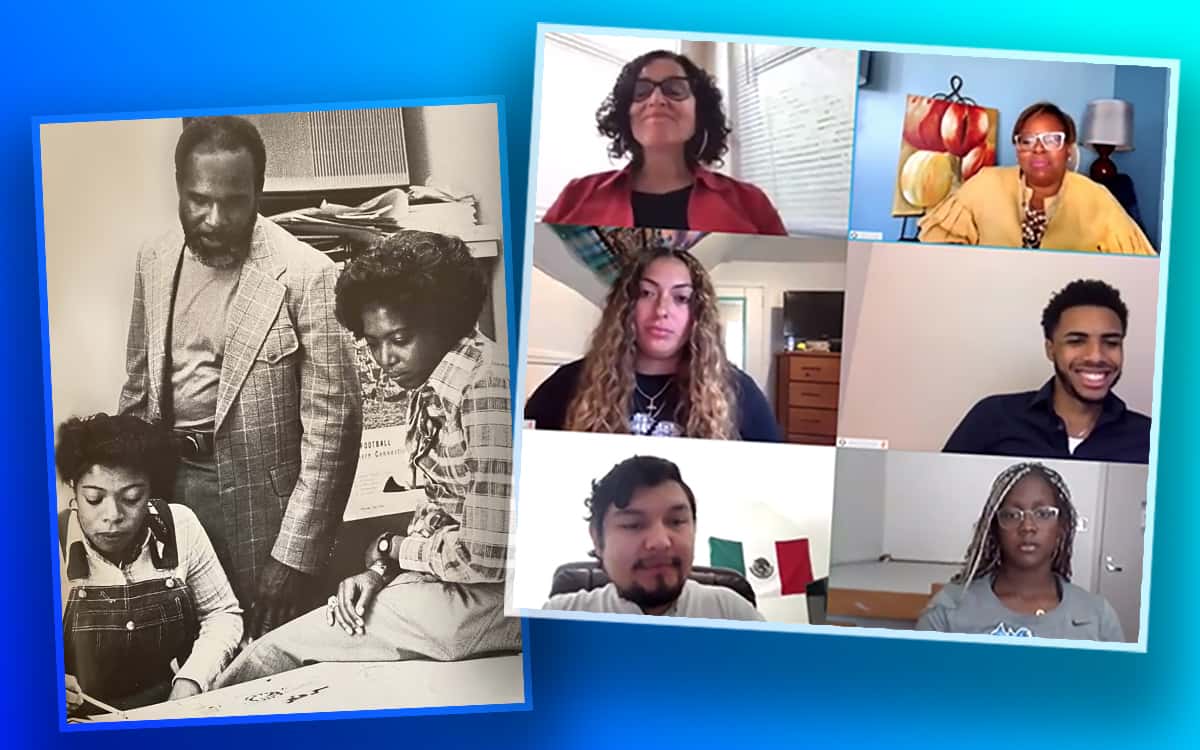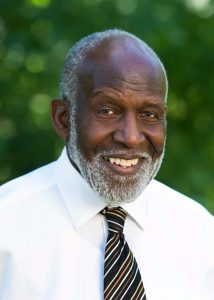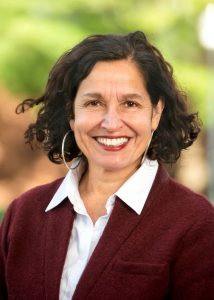Southern Connecticut State University is committed to a mission of social justice, and to address that mission more directly, the university recently welcomed its first vice president for diversity, equity, and inclusion, Dr. Diane Ariza. For the past several months, Ariza has been working to develop the new DEI division, and an important part of that work has been the creation of a website that speaks to Southern’s commitment to social justice.
Although the DEI division is new to Southern, the work of diversity, equity, and inclusion is not new to the institution, and it’s possible that no one knows better than Mr. James Barber how far the university has come and how far it still has to go.
For more than 50 years, James Barber, ‘64, M.S. ’79, has given dedicated service to Southern, its students, and the surrounding community. In 1971, Barber launched Southern’s first Summer Educational Opportunity Program (SEOP), which over time successfully opened the door to a college degree for scores of minority students. He also led the university’s affirmative action office in the 1970s, served as director of student supportive services for more than 20 years, and now helps to advance Southern’s mission as director of community engagement.
In 2020, Diane Ariza was named as Southern’s first vice president for diversity, equity and inclusion (DEI), following a national search for this new senior leadership position. She brought to the position more than two decades’ experience of administrative leadership in social justice and a background of teaching and research in ethnic studies. Most recently, Ariza served as chief diversity officer at Quinnipiac University and as vice president for community and belonging at Nazareth College in Rochester, N.Y. As an administrator and strategist at both institutions, she worked with senior leadership teams to promote greater access and inclusion through systematic and structural change, ensuring that all students, faculty, and staff reach their fullest potential.
Here, Barber and Ariza trace the past, present, and future of DEI and social justice at Southern.
Q) Mr. Barber, you were an undergraduate at Southern in the early 1960s. How would you describe the institution in terms of diversity and inclusion in that era?
A) There was no focus or sensitivity to the areas of diversity and inclusion as it related to attracting or retaining students of color nor addressing the exclusionary hiring practices. There was some recognition during my early days as teaching faculty, by both Dr. Buley as well as Dr. Middlebrooks, Vice President for Academic Affairs, that change needed to occur. Dr. Buley who was president during my undergraduate days and, with the encouragement of Dr. Jim Moore, was the person who brought me back to the university’s teaching faculty, was becoming somewhat sensitive to the fact that there needed to be a cultural change. In spite of his recognition, as president, for a need to begin addressing and initiate change, the rest of the university was not ready. Diversity, Inclusion and Equity was not on the university’s radar.
Q) In 1971, you launched Southern’s first Summer Educational Opportunity Program (SEOP), which over time successfully opened the door to a college degree for many minority students. How did you come to develop this program, and how have you seen it impact students?
A) The SEOP program was the outgrowth of 2 years of strategic planning, meeting weekly with the Organization of Afro-American Students (Black Student Union) and the few faculty of color employed during that period covering 1969-1971. We knew that in order for change to occur, that would benefit students of color, that we had to change the thinking of policy makers and some faculty. There were several critical issues that needed to be addressed:
First we needed to begin addressing the cultural climate on campus, both in and outside of the classroom. We especially needed to begin to expose the campus community to the contributions made by people of color to the arts, which included music, theatre, dance, etc. The university was like a castle with a moat around it located in an urban environment.
Second: We needed to ensure a stronger support system for students of color.
Third: We needed to ensure that there were more students of color around the table when decisions that were going to affect/effect their existence on campus were being made.
The SEOP program, which was designed to look beyond SAT/ACT scores and assess the whole person, has been successful. For a significant period of time the average graduation rate for students who had successfully completed the program was higher than that of students who were outright admits. We have had individuals who have gone on to careers in medicine, law, education, social work, wealth management and many other professions. The minority student enrollment at Southern prior to the beginning of the program was approximately 1/10th of 1 percent.
One of the areas that needs to be highlighted is the 25 years when I was Director of Student Supportive Services. When I assumed responsibility for the department in 1989, it had six existing but siloed programs: Veterans Advisement, SEOP, Disability Resources, International Students Advisement, Tutorial Center, and the Writing Center. We broadened the departmental outreach to do the following: educate the campus community of the significance of the mission and objectives of the existing programs; develop a program that was similar to SEOP but would provide an opportunity for students who for whatever reason could not participate in a program that had a residential mandate; create programs that had an intentional focus on early intervention; and academic enrichment and support for middle and high school students who resided in the Greater New Haven area. To address the latter I aggressively pursued grant funding to kickstart and sustain 4 new programs: ConnCAS, which provided support for a commuter students’ summer educational program; ConnCAP, which provided funding for a year around academic enhancement and support program for middle school students who would eventually transition into high school; Let’s Get Ready, a preparatory program funded by Goldman Sachs, for local high school students; and ConnCAB, which provided funds to establish the university’s book loan library. The University Student Success Center now embraces the work with students that was previously the focus of the Writing Center and Tutorial Center.
Q) You were also instrumental in the development of the first affirmative action plan for Southern. When did this work take place, and how did it come about?
A) I believe that we filed our first Affirmative Action Plan in 1976. I was a member of the group that wrote the plan. The process was initiated when I decided to take a couple of students of color and a colleague, who at the time was chairperson of the university’s Urban Studies Program, to Brown University, to the first weekend conference in New England on AA Plan Development. It was hosted by a Southern alum, who, at the time, was the assistant to the president at Brown. We wrote the plan and my colleague was appointed to the position of Director of AA. Eventually, I was asked to assume the role, a position that I held for about 8 years.
Q) Your career as a track and field coach was an important part of your journey at Southern and beyond. How has your work in athletics related to your work in the DEI arena?
A) I have had the privilege of a journey through the world of track and field, which began in 1964 with SCSC Men’s Track and Field and has provided me many opportunities to engage and coach at every level of the sport, both nationally and internationally. I initiated in 1975, with the assistance of 2 SCSU undergraduate students, a grassroots youth program that has had over 5000 children, attracting young athletes from as far south as Bridgeport, north to Waterbury and New Milford, and all along the shoreline. In spite of the fact that it was an athletic program, the intentional focus on diversity and inclusion is why this volunteer program is still attracting families in the year 2021.
Q) You are now advancing Southern’s mission as the university’s director of community engagement. How does this role enable you to impact diversity, equity, and inclusion at Southern?
A) My role as director of community engagement provides me opportunities to reach out without boundaries to every segment of the local, statewide, and sometimes national community on behalf of the university, students, faculty, staff and alumni.
Q) Dr. Ariza, what do diversity, equity, inclusion, and belonging mean to you?
A) It is central to Southern’s mission as an educational institution to ensure that each member of our community has full opportunity to thrive in our environment.
Diversity: Commitment to increasing diversity, which is expressed in myriad forms, including race and ethnicity, gender and gender identity, sexual orientation, socioeconomic status, language, culture, national origin, religious commitments, age, (dis)ability status and political perspective.
Equity: Commitment to working actively to challenge and respond to bias, harassment, and discrimination. We are committed to a policy of equal opportunity for all persons and do not discriminate on the basis of race, color, national origin, age, marital status, sex, sexual orientation, gender identity, gender expression, disability, religion, height, weight, or veteran status.
Inclusion: Commitment to pursuing deliberate efforts to ensure that our campus is a place where differences are welcomed, different perspectives are respectfully heard and where every individual feels a sense of belonging and inclusion. We know that by building a critical mass of diverse groups on campus and creating a vibrant climate of inclusiveness, we can more effectively leverage the resources of diversity to advance our collective capabilities.
However, these words sometimes can lose meaning over time. “Diversity” is a decent word. It is. Companies and politicians started weaving “diversity” into their lexicon in the 1990s, attaching it to many well-meaning, outward-facing initiatives. But their overuse of the word is part of what has hung it with a connotation that’s forced and inauthentic.
Belonging – Having a sense of belonging is a common experience. Belonging means acceptance as a member or part. Such a simple word for a huge concept. A sense of belonging is a human need, just like the need for food and shelter.
“Diversity is being invited to the party. Inclusion is being asked to dance, and Belonging is having my music played.”
Q) How long have you been involved in DEI work, and how did you get started in it?
A) Reflecting back, I have to say the work started when I was a child growing up in a bi-racial, bi-lingual, bi-cultural household and community in Puerto Rico. It was just more interesting and fun growing up where one could hear different languages, eat different foods, and engage in different practices and beliefs that made life vibrant and exciting!
As I got older, though, I realized that not everyone celebrated my joy in the same way, and noticed even within my family that prejudice and racism existed as well as in school, and community. I wanted to change that! Wanted to understand why this was and pursued majors in history, sociology, anthropology, and ethnic studies that provided meaning, context and critical understanding for why these social problems in our society and in the world existed. Thirty years later, I have become a stronger thinker and practitioner in my professional career including teaching, admissions, student services, enrollment management. When I make decisions, I try to think how will this impact individuals, whether they are non-traditional, commuters, food and housing insecure, with disabilities, etc.
Q) Why is DEI work particularly important in the higher education sphere?
A) In The Compelling Need/or Diversity in Higher Education (1999), documenting expert testimony in two law suits brought against the University of Michigan’s race-conscious policies in undergraduate and law school admissions, Gurin argued student experiences with racial and ethnic diversity in college have far-ranging and significant educational benefits, including preparation for democratic citizenship in the post-college world.
Other benefits beyond preparation for democratic citizenship is the value to having a diverse workforce. Evidence suggests:
Start with a variety of world views in one room, and you’ll come out of the other side with better ideas…
Increased Creativity…
Increased Productivity…
Reduced Fear, Improved Performance…
Boost Your Brand’s Reputation…
Global Impact…
I can’t think of any better industry that prepares students over time to learn, stumble, problem solve, and become better leaders and practitioners.
Morever, today colleges and universities are experiencing “perhaps the biggest upsurge in student activism since the 1960s.” Today, students are actively organizing around issues of diversity, equity and inclusion. This new group of DEI champions wants something different, including more formalized recognition for their knowledge, skill and efforts; more advanced training; and professional opportunities for leadership roles.
Q) What do you think are the biggest challenges of doing DEI work? What are the biggest opportunities?
A) Some of the biggest challenges:
There still is an expectation that DEI VPs or CDOs will provide the fixes for everyone without others doing the work, and I mean really doing the “hard” work.
Dismantling systemic oppression and racism takes time. However folx mostly affected by these systems are tired, really tired, broken and harmed. We have no time to waste.
Many are doing the hard work, however, they are still doing it in silos and not collaboratively and intently.
We need to measure our success. Fifty more programs/events will not change culture or climate on campus if we don’t measure over time and hold folx accountable.
Training programs are not just checking the box and saying “I did it.” How does one take responsibility to continuously reflect on this work and do better?
Opportunities:
The nation is woke all of a sudden since the summer racial violence and murders of black individuals. There is a reality that we must do better, and quickly! As I said earlier, Gen Zs are actively organizing around issues of diversity, equity and inclusion. This new group of DEI champions wants something different, including more formalized recognition for their knowledge, skill and efforts; more advanced training; and professional opportunities for leadership roles. And they are willing to take on the system!
Q) As the first vice president for DEI at Southern, how do you see your role in helping to move the institution forward? What is the DEI Division working on now, and what are your plans for the first few years on campus?
A) I remember when interviewing for the position at Southern, I was asked how would I help to move the institution forward? I responded with the following analogy: Southern has an amazing orchestra with fine musicians doing anti-racist and social justice work. My role as the conductor of the orchestra is to unify a large group of musicians into a core sound instead of a wild bunch of different sounds surging out; unify performers, set the tempo, execute clear preparations and beats, listen critically and shape the sound of the ensemble, and to control the interpretation and pacing of the music.




